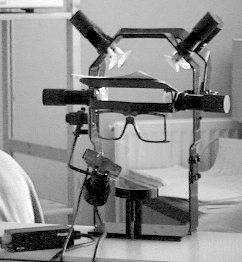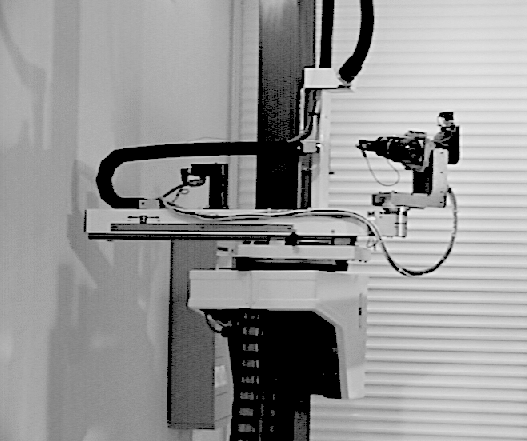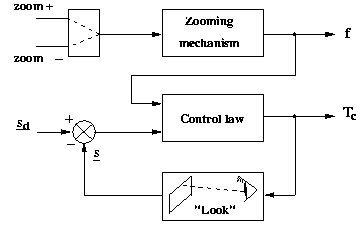
Contact: Fabien Spindler
Creation Date : April 1997
This demonstration, carried out in real time on the cylindrical robotic vision cell, presents the results of the control of a camera using human eye movements. Indeed, the camera mounted on the end-effector of our robot is controlled using the direction of the glance of an operator looking at a monitor that displays the images acquired by this camera. To perform this task, we use an eye-tracker. After a preliminary step of calibration, the eye-tracker allows to extract the coordinates in the image of the region of interest observed by the operator. The vision task consists in moving, by visual servoing, this region of interest at the center of the image by controlling the orientation of the camera. In addition, the operator can also operate the zoom of the camera to obtain more details on the observed scene.

A video film titled "control of a camera by the glance" was produced by inria

|

|
|---|---|
| The eye-tracker | The cylindrical robot |
An eye-tracker is a device able to measure the direction of the glance of an operator. Our EYEPUTER system was developed by the LETI in Grenoble and marketed by the company Alpha Bio Technologies. This eye-tracker is built on a standart set of acquisition and image processing techniques. He is composed of an optical system, a CCD camera and two infra-red sources. The camera acquires at video rate the images of the right eye, alternatively lighted by one of the two infra-red sources. Computations are performed on a classical PC 486 equipped with an image processing board. The analysis of the position of the pupil and the two cornea reflections makes it possible to determine the direction of the glance of the operator. Moreover, after a preliminary stage of calibration consisting in projecting a calibration grid on a TV screen in front of the operator, the system is able to determine the position (X, Y) observed in the screen by the operator.
This robot is a four degrees of freedom Afma Robots cylindrical manipulator. A CCD Sony camera is mounted on the end effector of the robot. This camera can be controlled in pan and tilt. In addition, a Servolens X10 lens is attached to the camera. Its zoom varying from 10mm to 100mm, its focus and its iris can be controlled via a RS232 serial port.

|
|---|
| The visual servoing controller |
The aimed domain is the remote monitoring of sensitive sites (carparks, banks) or the intervention in contaminated nuclear sites. The use of cameras whose movements can be controlled brings a greater flexibility compared to the use of many fixed cameras. Moreover, a fine exploration of the selected region of interest can be carried out.
This study lies within the scope of the research carried out in visual servoing. Furthermore we study, in collaboration with the Temics project at Irisa, the issue of selective image compression.
This work is done within the framework of the 11th contract between French State and the Brittany council, and more precisely within the VIDAC project with the CEMAGREF (Rennes) and the Temics project at Irisa.
|
| Lagadic
| Map
| Team
| Publications
| Demonstrations
|
Irisa - Inria - Copyright 2009 © Lagadic Project |